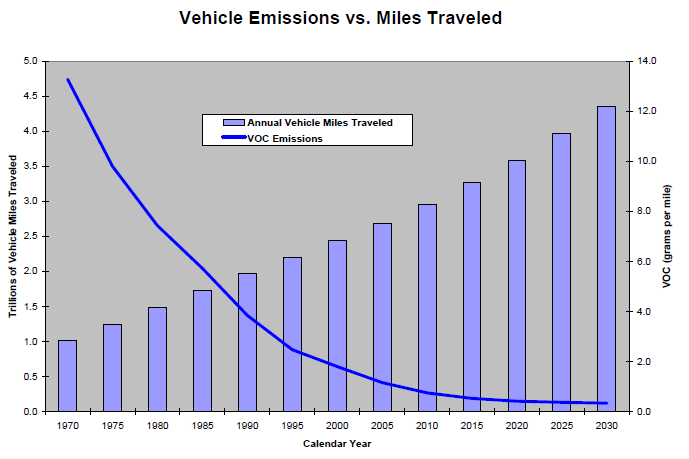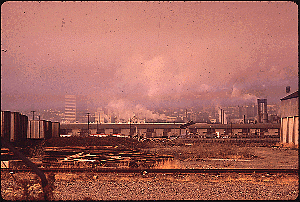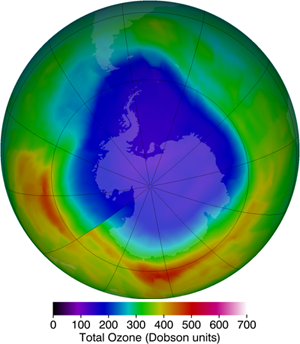Progress Cleaning the Air and Improving People's Health
The Clean Air Act has a proven record of public health and environmental protection since 1970.
Quick Overview
-
The value of Clean Air Act health benefits far exceeds the costs of reducing pollution.
-
New cars, trucks, and nonroad engines use state-of-the-art emission control technologies.
-
New plants and factories install modern pollution control technology.
-
Power plants have cut emissions that cause acid rain and harm public health.
-
Mobile and industrial pollution sources release much less toxic pollution to the air than in 1990.
-
Actions to protect the ozone layer are saving millions of people from skin cancers and cataracts.
-
The scenic vistas in our national parks are clearer due to reductions in pollution-caused haze.
-
EPA has taken initial steps to limit emissions that cause climate change and ocean acidification.
Detailed Summary: Clean Air Act Results
For more than forty-five years the Clean Air Act has cut pollution as the U.S. economy has grown.
-
Experience with the Clean Air Act since 1970 has shown that protecting public health and building the economy can go hand in hand.
-
Clean Air Act programs have lowered levels of six common pollutants -- particles, ozone, lead, carbon monoxide, nitrogen dioxide and sulfur dioxide -- as well as numerous toxic pollutants.
-
From 1970 to 2017, aggregate national emissions of the six common pollutants alone dropped an average of 73 percent while gross domestic product grew by 324 percent. This progress reflects efforts by state, local and tribal governments; EPA; private sector companies; environmental groups and others.
-
The emissions reductions have led to dramatic improvements in the quality of the air that we breathe. Between 1990 and 2017, national concentrations of air pollutants improved 80 percent for lead, 77 percent for carbon monoxide, 88 percent for sulfur dioxide (1-hour), 56 percent for nitrogen dioxide (annual), and 22 percent for ozone. Fine particle concentrations (24-hour) improved 40 percent and coarse particle concentrations (24-hour) improved 34 percent between 2000, when trends data begins for fine particles, and 2015. (For more trends information, see EPA's Air Trends site.)
-
These air quality improvements have enabled many areas of the country to meet national air quality standards set to protect public health and the environment. For example, all of the 41 areas that had unhealthy levels of carbon monoxide in 1991 now have levels that meet the health-based national air quality standard. A key reason is that the motor vehicle fleet is much cleaner because of Clean Air Act emissions standards for new motor vehicles.
-
Airborne lead pollution, a widespread health concern before EPA phased out lead in motor vehicle gasoline under Clean Air Act authority, now meets national air quality standards in most areas of the country.
-
State emission control measures to implement the Act, as well as EPA's national emissions standards, have contributed to air quality improvements.
Because of the Act, Americans breathe less pollution and face lower risks of premature death and other serious health effects.
A peer-reviewed EPA study issued in March 2011 found that the Clean Air Act Amendments of 1990 are achieving large health benefits that will grow further over time as programs take full effect.
This chart shows the health benefits of Clean Air Act programs that reduce levels of fine particles and ozone.
| Health Effect Reductions (PM2.5 & Ozone Only) | Pollutant(s) | Year 2010 | Year 2020 |
|---|---|---|---|
| PM2.5 Adult Mortality | PM | 160,000 | 230,000 |
| PM2.5 Infant Mortality | PM | 230 | 280 |
| Ozone Mortality | Ozone | 4,300 | 7,100 |
| Chronic Bronchitis | PM | 54,000 | 75,000 |
| Acute Bronchitis | PM | 130,000 | 180,000 |
| Acute Myocardial Infarction | PM | 130,000 | 200,000 |
| Asthma Excaberation | PM | 1,700,000 | 2,400,000 |
| Hospital Admissions | PM, Ozone | 86,000 | 135,000 |
| Emergency Room Visits | PM, Ozone | 86,000 | 120,000 |
| Restricted Activity Days | PM, Ozone | 84,000,000 | 110,000,000 |
| School Loss Days | Ozone | 3,200,000 | 5,400,000 |
| Lost Work Days | PM | 13,000,000 | 17,000,000 |
- The 2011 report did not include the large benefits of the pre-1990 Clean Air Act. A peer-reviewed 1997 EPA Report to Congress reviewed the benefits of the Act from 1970 to 1990, and concluded that in 1990 alone, pollution reductions under the Act prevented 205,000 early deaths, 10.4 million lost I.Q. points in children due to lead exposure, and millions of other cases of health effects.
- Independent scientific research shows that reductions in air pollution are associated with widespread public health benefits. For example, one study found that reductions in fine particle pollution between 1980 and 2000 in U.S. cities led to improvements in average life expectancy at birth of approximately seven months.1
Environmental damage from air pollution is reduced.
-
Lower air pollution levels mean less damage to the health of ecosystems.
-
Environmental effects of air pollution include damage to plants and long-term forest health, soil nutrient deterioration, accumulation of toxics in the food chain, damage to fish and other aquatic life in lakes and streams, and nitrogen enrichment of coastal estuaries causing oxygen depletion and resulting harm to fish and other aquatic animal populations.
-
Reducing air pollution also improves crop and timber yields, a benefit worth an estimated $5.5 billion to those industries' welfare in 2010, according to the peer-reviewed March 2011 EPA study. Better visibility conditions in 2010 from improved air quality in selected national parks and metropolitan areas had an estimated value of $34 billion.
The value of Clean Air Act health benefits far exceeds the costs of reducing pollution.
-
EPA’s peer-reviewed 2011 study found that clean air programs established by the 1990 CAA amendments are expected to yield direct benefits to the American people which vastly exceed compliance costs.
-
The study's central benefits estimate of $2 trillion in 2020 exceeds costs by a factor of more than 30-to-1, and the high benefits estimate exceeds costs by 90 times. Even the low benefits estimate exceeds costs by about 3-to-1.
-
In addition to direct benefits vastly exceeding direct costs, economy-wide modeling conducted for the study found that the economic welfare of American households is better with post-1990 clean air programs than without them.
-
Economic welfare and economic growth rates are improved because cleaner air means fewer air-pollution-related illnesses, which in turn means less money spent on medical treatments and lower absenteeism among American workers. The study projects that the beneficial economic effects of these two improvements alone more than offset the expenditures for pollution control.
-
The EPA report received extensive review and input from the Council on Clean Air Compliance Analysis, an independent panel of distinguished economists, scientists and public health experts established by Congress in 1991.
New cars, trucks, and nonroad engines use state-of-the-art emission control technologies.
EPA has required dramatic reductions in emissions from new motor vehicles and non-road engines - such as those used in construction, agriculture, industry, trains and marine vessels -- through standards that require a combination of cleaner engine technologies and cleaner fuels. In 2013, EPA estimated the benefits of five key standards to cut emissions from vehicles, engines and fuel to 2030.

-
Compared to 1970 vehicle models, new cars, SUVs and pickup trucks are roughly 99 percent cleaner for common pollutants (hydrocarbons, carbon monoxide, nitrogen oxides and particle emissions), while Annual Vehicle Miles Traveled has dramatically increased.
-
New heavy-duty trucks and buses are roughly 99 percent cleaner than 1970 models. In August 2016, EPA and the U.S. Department of Transportation’s National Highway Traffic Safety Administration (NHTSA) jointly finalized standards for medium- and heavy-duty vehicles that will improve fuel efficiency and cut carbon pollution, while bolstering energy security and spurring manufacturing innovation.
-
Starting in the 2014 model year, locomotives are 90 percent cleaner than pre-regulation locomotives. In March 2008, EPA finalized a three part program that dramatically reduces emissions from diesel locomotives of all types -- line-haul, switch, and passenger rail. The rule cuts particulate emissions from these engines by as much as 90 percent and nitrogen oxides emissions by as much as 80 percent when fully implemented. <Learn more about regulations for emissions from locomotives.>
-
New commercial marine vessels (non-ocean-going) are 90 percent cleaner for particle emissions than in 1970. Clean Air Act and international standards for ocean-going vessel emissions and fuels are reducing emissions from ocean-going vessels as well. <Learn more about ocean vessels and large ships.>
-
EPA is taking action to reduce emissions caused by Aircraft. In 2016, EPA finalized findings that GHG emissions from certain classes of engines used in aircraft contribute to the air pollution that causes climate change endangering public health and welfare under section 231(a) of the Clean Air Act. <Learn more about Regulations for Greenhouse Gas Emissions from Aircraft>
-
Sulfur in gasoline has been reduced by 90 percent, and sulfur in diesel fuel has been reduced by 99 percent, from pre-regulation levels.
New power plants and factories use modern pollution control technology.
- The Act requires that when new industrial facilities are designed and built, good pollution control must be part of the design. This means that as new, cleaner facilities are built, the country's industrial base becomes cleaner overall. Public health is protected as economic growth proceeds. <Learn more about stationary sources of air pollution.>
- In areas not meeting air quality standards, to avoid making pollution worse, new and modified large plants and factories must meet the lowest achievable emission rate and obtain offsetting emissions reductions from other sources.
- In areas that meet air quality standards, new and modified large plants and factories must apply the best available technology considering cost and avoid causing significant degradation of air quality or visibility impairment in national parks.
- For example, new coal-fired power plants typically install control devices that capture up to 98 percent of the sulfur dioxide and in many cases 90 percent of the nitrogen oxide emissions, relative to uncontrolled levels.
- These requirements are applied through pre-construction permitting programs that are administered by state, local, tribal, or EPA permitting authorities, depending on the location.
- State and local permitting authorities usually administer the pre-construction permit programs that determine how to apply these requirements to facilities.
Power plants have cut emissions that cause acid rain and harm public health.

- A national system of marketable pollution allowances has dramatically cut power plant emissions of sulfur dioxide, reducing acid rain as well as secondary formation of fine particle pollution that contributes to premature death. Acid rain, which includes wet and dry deposition of acidic compounds from the atmosphere, results from emissions of sulfur dioxide and nitrogen oxides.
- Reducing acid rain has significantly reduced damage to water quality in lakes and streams, and improved the health of ecosystems and forests.
- Between the 1989 to 1991 and 2009 to 2011 observation periods, wet deposition of sulfate (which causes acidification) decreased by more than 55 percent on average across the eastern United States.
- The dramatic emissions reductions achieved by the acid rain program have helped to reduce atmospheric levels of fine particle pollution, avoiding numerous premature deaths.
- Government and independent analyses have concluded that the benefits of the program far outweigh the costs, as detailed in the U.S. government's National Acid Precipitation Assessment Program (NAPAP) 2011 Report to Congress (PDF). (132 pp, 14.5 MB, About PDF)
- Multiple analyses show that the cost of the fully implemented program is a fraction of the originally estimated cost - between $1-2 billion annually rather than the $6 billion EPA originally estimated in 1990, according to the NAPAP report.
Interstate air pollution has been reduced.
Further reductions in power plant pollution have been achieved by state and EPA efforts to cut interstate air pollution, achieving additional public health benefits and helping downwind states meet health-based air quality standards for fine particles and ozone.
- Twelve New England and mid-Atlantic states and the District of Columbia -- the Ozone Transport Region created by the 1990 Amendments -- worked together to create a nitrogen oxides (NOx) Budget Program and to adopt other controls that help improve ozone levels throughout the region.
- Building on that success, EPA issued a broader “NOx SIP Call” Rule creating a similar NOx Budget Trading Program for much of the eastern United States, which ran from 2003 to 2008. As of 2008, the program cut summertime NOx emissions from power plants by 62 percent from 2000 levels. These reductions, along with the NOx reductions from federal motor vehicle standards, are responsible for substantial improvement in ozone levels across the eastern United States.
- The subsequent Clean Air Interstate Rule (CAIR) has achieved large reductions in power plant annual SO2 and NOx emissions that contribute to fine particles, as well as some additional summertime NOx reductions beyond those required by the NOx SIP Call.
- CAIR, which had initial compliance deadlines in 2009 and 2010, is a major reason that almost all areas in the East have met the 1997 and 2006 air quality standards for fine particles. In the 2005 CAIR Regulatory Impact Analysis, EPA estimated that the reductions from the CAIR requirements would avoid 13,000 premature deaths a year in 2010.
- CAIR was replaced by the Cross-State Air Pollution Rule, as of January 1, 2015 to address the 1997 ozone National Ambient Air Quality Standards (NAAQS).
- On September 7, 2016, the EPA revised the CSAPR by finalizing an update for the 2008 ozone NAAQS, known as the CSAPR Update. CSAPR Update will further reduce summertime NOX emissions from power plants in the eastern U.S. and help downwind states to meet the new ozone standards.
Mobile and industrial pollution sources release far less toxic air pollution than in 1990.

- Stationary sources today emit about 1.5 million tons less toxic air pollution per year than in 1990.2
- EPA has issued emissions standards to control toxic emissions from all 174 categories of major sources (e.g., chemical plants, oil refineries, aerospace manufacturing facilities, etc.), as well as from 68 categories of small “area” sources that represent 90 percent of the worst urban toxic pollutants.3 States have elected to administer or enforce many of these federal standards.
- Toxic emissions from onroad and nonroad vehicles and engines also are dropping due to requirements for cleaner fuels and engines.4
- These emissions are projected to be reduced by 80 percent by 2030 from 1990 levels.
- Onroad and nonroad diesel particulate matter emissions decreased by about 27 percent from 1990 to 2005 and are projected to be reduced an additional 90 percent from 2005 to 2030.
- Airborne levels of benzene, a carcinogen found in gasoline, declined by 66 percent from 1994 to 2009 based on available air quality monitoring information.5
- Mercury emissions fell by about 80 percent between 1990 and 2014.6 EPA regulations for several large sources of mercury such as municipal waste combustion and medical waste incineration played a significant role.
- Power plants remain the largest man-made source of mercury emissions in the United States, emitting more than half of all emissions of certain air toxics.
- The 2012 Mercury and Air Toxics Standards for power plants require power plants to reduce their emissions of mercury and other toxic air pollutants, protecting Americans from a host of avoidable illnesses and premature death.
- The pollutants reduced under MATS are associated with harm to the developing nervous systems of unborn babies and children, cancer, and with contributing to asthma and other respiratory diseases.
- The compliance date for MATS was in 2015, and power plants have taken steps such as installing controls or updating operations to meet these standards that protect public health.
- The technologies used to reduce toxic pollution also reduce sulfur dioxide and fine particle pollution, with additional benefits for public health.
- MATS was estimated to prevent up to 11,000 premature deaths, 4,700 heart attacks and 130,000 asthma attacks annually beginnning in 2016.
- The value of the quantified air quality improvements from MATS for people's health alone totals $37 billion to $90 billion each year. That means that for every dollar spent to reduce this pollution, Americans get $3-9 in health benefits. These significant health benefits do not include the benefits associated with reducing air toxics emitted from power plants because EPA does not at this time have the ability to quantify such benefits. Thus, the Agency is likely underestimating the benefits of the rule.
- The benefits of MATS are widely distributed and are especially important to minority and low income populations who are disproportionately impacted by asthma and other debilitating health conditions.
- Up to 540,000 missed work or "sick" days were estimated to be avoided each year beginning in 2016, enhancing productivity and lowering health care costs for American families.
- The technologies used to reduce toxic pollution also reduce sulfur dioxide and fine particle pollution, with additional benefits for public health.
Actions to protect the ozone layer are saving millions of people from fatal skin cancers and eye cataracts.
- Actions to protect the stratospheric ozone layer will save millions of American lives from skin cancer between 1990 and 2165. The actions also will avoid hundreds of millions of non-fatal skin cancers and tens of millions of cases of eye cataracts for Americans born between 1985 and 2100, according to a peer-reviewed 1999 EPA study.
- The United States is one of 197 countries that are parties to the Montreal Protocol, an international treaty to protect the ozone layer. In 2012 the treaty marked its 25th anniversary. Helping developing countries comply through mechanisms like the Montreal Protocol's Multilateral Fund (MLF) will help assure success in restoring the ozone layer. Scientists estimate recovery by the middle of the 21st century. <Learn more about the Montreal Protocol.>
- Consistent with the Montreal Protocol, the Clean Air Act requires that EPA develop and implement regulations for the responsible management of ozone-depleting substances in the United States to help restore the ozone layer. The law uses multiple tools including the phase-out of certain chemicals, bans on nonessential products containing or made with such chemicals, and prohibition of the release of ozone-depleting refrigerants during the service, maintenance, and disposal of air conditioners and other refrigeration equipment.
- The United States already has phased out the ozone depleting substances that Congress identified as "most damaging," such as CFCs and halons.
- The phase-out for Class I substances was implemented 4-6 years faster, included 13 more chemicals, and cost 30 percent less than was predicted at the time the 1990 Clean Air Act Amendments were enacted. EPA's peer-reviewed 1999 study found that under the primary estimate, every dollar invested in ozone layer protection provides $20 of societal health benefits in the United States, and that after accounting for uncertainties, the benefits still far outweigh the costs.
The scenic vistas in our national parks are clearer due to reductions in pollution-caused haze.


- The acid rain program, interstate air pollution rules, motor vehicle rules and diesel sulfur rules have dramatically cut sulfur dioxide and nitrogen oxide emissions that contribute to fine particle pollution. This has improved visibility over broad regions, including many of our national parks. <Learn more about Protecting our Nation's Treasured Vistas.>
- Further visibility improvements are anticipated from the regional haze program mandated by Congress. As of January 15, 2013, EPA has taken more than 100 proposed or final actions on Regional Haze State Implementation Plans. Out of 52 required plans, there are 45 plans in place to ensure control of emissions that impair visibility in national parks and wilderness areas.
- States, tribes, and five multi-jurisdictional regional planning organizations worked together to develop the technical basis for these plans. Comprehensive periodic revisions to these initial plans are currently due in 2018, 2028, and every 10 years thereafter.
EPA has taken initial steps under the Act to limit emissions that cause climate change and ocean acidification.
- Consistent with a 2007 Supreme Court decision, EPA in 2009 completed a scientific determination that greenhouse gases in the atmosphere are reasonably anticipated to endanger the public health and welfare of current and future generations and that emissions of greenhouse gases from new motor vehicles contributes to this air pollution.
- EPA's first steps to reduce harmful greenhouse gas pollution focused on motor vehicles. Transportation sources in 2010 were responsible for more than a quarter of U.S. greenhouse gas emissions.7
- EPA and the National Highway and Traffic Safety Administration worked together to set greenhouse gas and fuel economy standards for passenger vehicles in model years 2012-2016 and 2017-2025.
- Over the life of these vehicles, the standards will save an estimated $1.7 trillion for consumers and businesses and cut America's oil consumption by 12 billion barrels, while reducing greenhouse gas emissions by 6 billion metric tons.
- EPA's and NHTSA's standards for heavy-duty trucks and buses, which were issued in August 2011, present large similar benefits. The final phase two program, finalized in August of 2016, promotes a new generation of cleaner, more fuel-efficient trucks by encouraging the wider application of currently available technologies and the development of new and advanced cost-effective technologies through model year 2027.
- In January 2011, states and EPA initiated Clean Air Act permitting of greenhouse gas pollution from the largest new and modified stationary sources. In the first year of permitting, dozens of large sources such as power plants, cement plants, refineries and steel mills received pre-construction permits for greenhouse gas emissions.
- On August 3, 2015, President Obama and the EPA unveiled the Clean Power Plan -- a historic and important step in reducing carbon pollution from power plants. On February 9, 2016, the Supreme Court stayed implementation of the Clean Power Plan pending judicial review. The Court’s decision was not on the merits of the rule. EPA firmly believes the Clean Power Plan will be upheld when the merits are considered because the rule rests on strong scientific and legal foundations.
- On May 12, 2016 EPA issued three final rules that together will curb emissions of methane, smog-forming volatile organic compounds (VOCs) and toxic air pollutants such as benzene from new, reconstructed and modified oil and gas sources.
-
On October 15, 2016, with the United States’ leadership, 197 countries adopted an amendment to phase down HFCs under the Montreal Protocol in Kigali, Rwanda. HFCs are greenhouse gases which can have warming impacts hundreds to thousands of times more potent than carbon dioxide. Under the amendment, countries committed to cut the production and consumption of HFCs by more than 80 percent over the next 30 years.
The Act has prompted deployment of clean technologies, and has helped provide impetus for technology innovations that reduce emissions and control costs.
- Catalysts, scrubbers, and low-VOC paints and coatings, are part of a long list of technologies that were not known in 1970, but are proven and widely deployed today. Examples include:
- Selective catalytic reduction (SCR) and ultra-low NOx burners for NOx emissions
- Scrubbers which achieve 95 percent and even greater SO2 control on boilers
- Sophisticated new valve seals and leak detection equipment, including cameras that can see leaks, for refineries and chemical plans
- Low or zero VOC paints, consumer products and cleaning processes
- Chlorofluorocarbon (CFC) and hydrochlorofluorocarbons (HCFC)-free air conditioners, refrigerators, aerosol sprays and cleaning solvents
- Water and powder-based coatings to replace petroleum-based formulations
- Vehicles far cleaner than believed possible in the late 1980s due to improvements in evaporative controls, catalyst design and fuel control systems for light-duty vehicles; and treatment devices and retrofit technologies for heavy-duty engines
- Idle-reduction technologies for engines, including truck stop electrification efforts
- Market penetration of gas-electric hybrid vehicles, and clean fuels
- Routine use of continuous monitoring technology that provides data more quickly
- Multi-pollutant monitors that helps us to better understand the complex nature of air pollution
<Learn more about the CAA and the economy>
References
1 Pope, C.A. III, E. Majid, and D. Dockery, 2009. “Fine Particle Air Pollution and Life Expectancy in the United States,” New England Journal of Medicine, 360: 376-386.
2 EPA, Air Toxics Web Site, About Air Toxics. (For the latest information about reducing air toxics, see the webpage, Reducing Emissions of Hazardous Air Pollutants.
3 EPA, Air Toxics Web Site, Rules and Implementation.
4 Mobile emissions estimates are based on modeling runs conducted using the MOVES2010 highway vehicle emissions modeling system and the NONROAD2008 emissions model for nonroad sources, as well as historical and projected activity and emission rate data for aircraft, marine vessels and locomotives.
5 Estimates of the change in national benzene emissions are based on benzene ambient air monitoring data in EPA's Air Quality System (U.S. EPA, 2010), using the subset of benzene monitoring stations that have sufficient data to assess trends since 1994.
6 Mercury emissions data for 1990, 2005, and 2008 featured in table 7 in the EPA 2008 National Emissions Inventory, Version 2 Technical Support Document, June 2012 draft.
7 EPA, (April 2012) Inventory of U.S. Greenhouse Gas Emissions and Sinks; 1990-2010.
